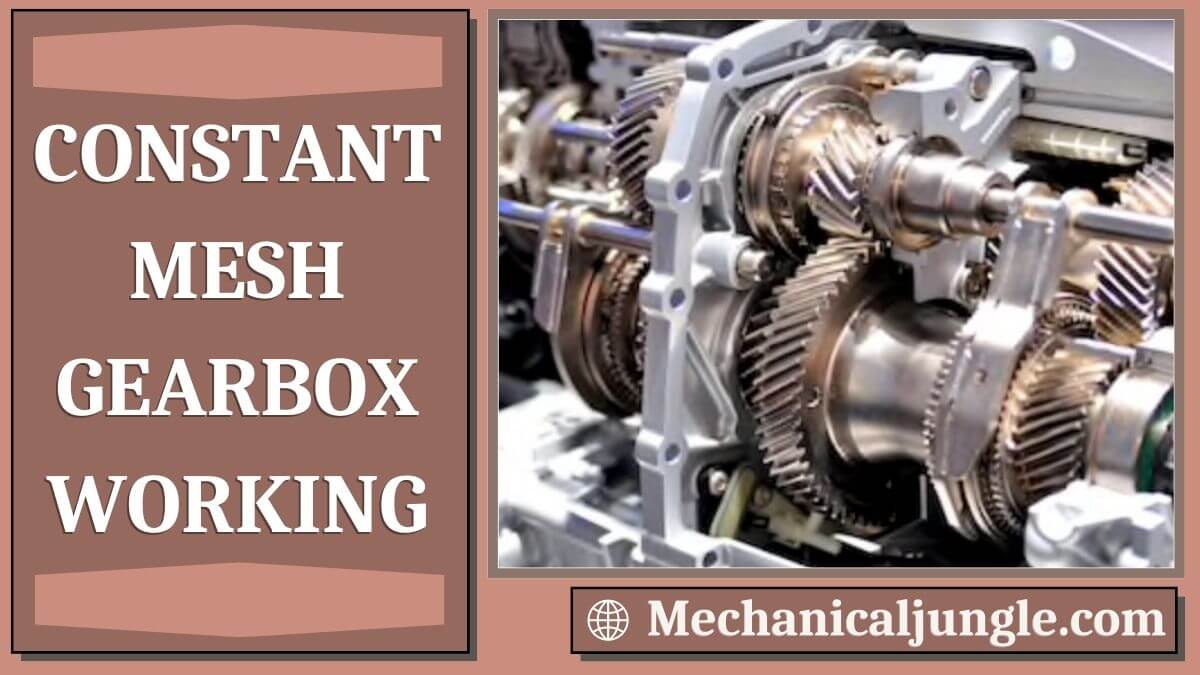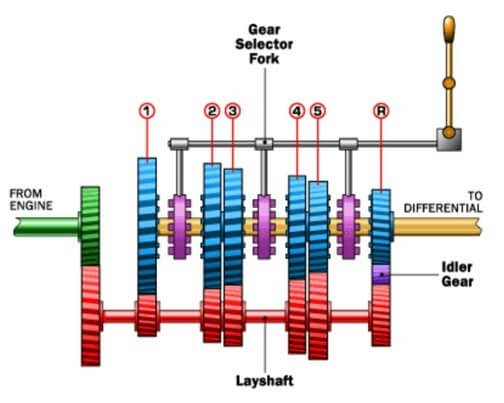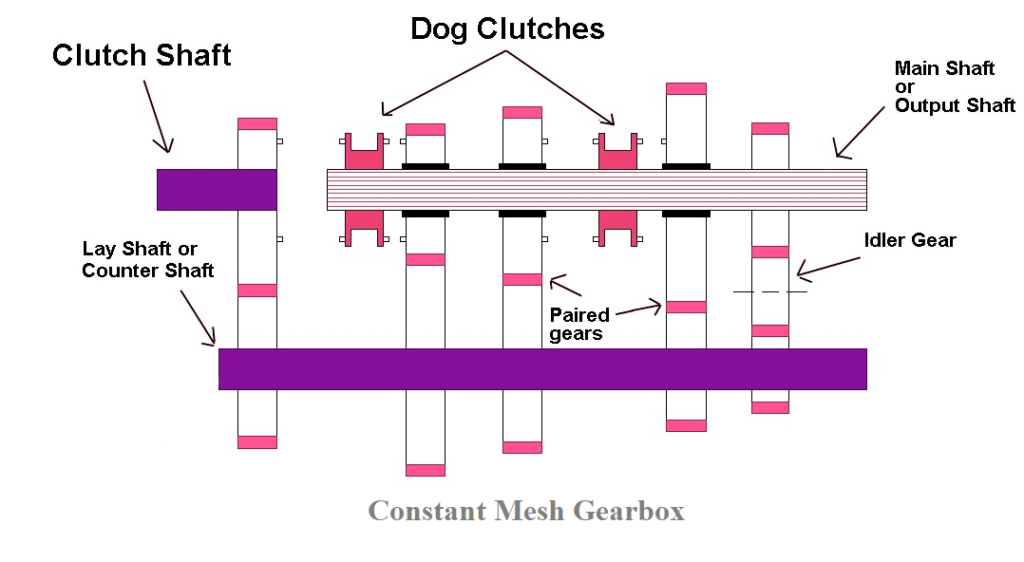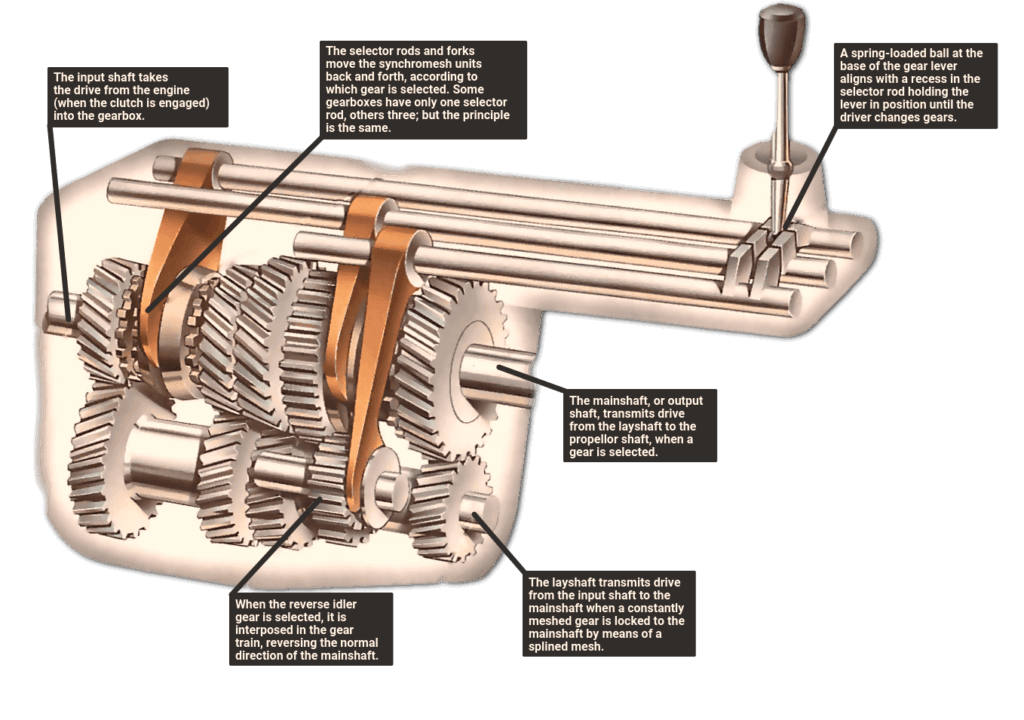Working of Constant Mesh Gearbox
Since the gear of the main shaft is in a continuous mesh with the appropriate gear of the continuous shaft, the selection of 1, 2, 3, 4, and reverse gears is achieved with the proper pair sliding and traps of the dog clutch.
Different gear ratios in Constant Mesh Gearbox
There are Five Gear types of this Constant Mesh Gearbox
- First gear
- Second gear
- Third gear
- Fourth gear
- Reverse gear
#1. First Gear
It is the gear that provides the maximum torque and minimum speed to the final output shaft that helps the vehicle move from its initial position when the driver selects one gear by pushing or pulling the gear lever, and the dog is in the clutch.
It is paired with the same pair. The gear, the smallest gear on the main shaft and the largest gear on the main shaft, slides right or left over the remaining main shaft and makes contact with the forged pair, and finally receives one gear.
#2. Second Gear
This gear provides higher speeds and lower torque than the first gear and is achieved by sliding right or left towards the corresponding dog clutch towards the appropriate pair of forged gears, the second the shorter shaft gear, and the second-largest main.
The shaft is gear—contact with the pair.
#3. Third Gear
This is the second-highest speed gear, with very low torque, and is achieved by sliding the right or left side of the respective dog clutch towards the appropriate pair of forged dogs, i.e., the second largest carry shaft gear and the second smallest main shaft gear.
#4. Fourth Gear
It is the highest-speed gear of a 4-speed manual transmission in which the maximum output of the clutches shaft is transmitted to the final output by sliding the dog clutch to the right or left to create the maximum contact with the left shaft and the smallest gear.
Is. The gear of the main shaft and very low torque, and the highest speed are obtained.
#5. Reverse Gear
This is the gear that reverses the direction of rotation of the output shaft to move the vehicle in the reverse direction; this is achieved with special gears known as idler gears, which when the reverse shaft has selected.
The clutch of the dog mounted between the left shaft and the main shaft makes contact with the idler gear and the reverse gear is obtained.
What is a Constant Mesh Gearbox?
- Constant-mesh gearboxes were invented to overcome the limitations of sliding mesh gearboxes. In this gearbox, all gears are always forged.
- The gear remains fixed and does not slide like a sliding mesh gearbox. In this gearbox, the sliding mesh was paired with continuously added gears, and new shifting devices called dog clutches were introduced. A continuous mesh gearbox typically comes with a 4-speed 1-reverse manual transmission configuration.
- This gearbox consists of various parts such as a countershaft, main shaft, clutch shaft, gear, and dog clutch. The gears on the coupler shaft are fixed to it and the gears on the main shaft are free to rotate. Helical and herringbone gears are commonly used in this gearbox, so it is quieter than a sliding gear gearbox that uses spire gears.
- In this gearbox, all the gears of the main shaft and countershaft are always connected with each other. Different transmission ratios or speed ratios are obtained using the dog’s clump. Dog clutches are attached with gears on the main shaft to achieve the desired speed or torque.
Construction of Constant Mesh Gearbox
- The output of the engine is done by a clutch shaft.
- The gear lay in the clutch shaft is in continuous mesh with the gear of the shaft.
- The lift shaft has five gears, one of which is connected to the gear of the clutch shaft, and the other four are connected to the gear of the main shaft.
- All four gears are of different sizes to achieve different gear ratios.
- An idler gear exists between the gear of the main shaft and the gear to form the reverse gear.
Working on Constant Mesh Gearbox
- Different gear ratios are obtained when the dog clutch is fitted with different gears of the main shaft because the main shaft is always paired with gears of gear counters of different gear ratios.
- If the dog clutch is not in contact with any gear of the main shaft, the gear of the main shaft rotates freely and does not rotate the main shaft as they are connected to the main shaft using bearings.
- The main shaft rotates only when a clutch of the dog is attached to any of the gears of the main shaft.
- The reverse gear is obtained in this gearbox using the same technique that was used in sliding the gearbox, i.e., using the idle gear between the main shaft gear and the countershaft gear.
Advantages of Constant Mesh Gearbox
- Different gear ratios are obtained when the dog clutch is fitted with different gears of the main shaft because the main shaft is always Constant mesh gearboxes are quitter as helical, or herringbone gears can be used instead of a spur gear in this gearbox.
- Since the gears are attached to the dog clutches, if there is any damage while entangling the gears, the members of the dog unit are damaged, not the gear wheels.
Disadvantages of Constant Mesh Gearbox
The disadvantages of a constant mesh gearbox are as follows.
- With the slight vibration that occurs during the engagement of the dog clutch with the gear on the main shaft, it is advisable to use a synchronizer, which can reduce the effect of vibration.
- The biggest disadvantage of the double dusting constant mesh gearbox was already mentioned above.
Application of Constant Mesh Gearbox
- The constant-mesh gearbox was mainly used in farm trucks, motorbikes, and heavy machinery. It is also used in cars like the Ford Model T.
- Prior to the introduction of the synchromesh gearbox in 1928 by General Motors, a constant mesh box was used in motorbikes.
Frequently Asked Questions (FAQ) about Constant Mesh Gearbox
What is a constant mesh gearbox?
A constant mesh gearbox is a type of gearbox where all gears are always engaged with their corresponding gears on the countershaft. It uses dog clutches for engaging different gears, offering smoother operation compared to sliding mesh gearboxes.
How does a constant mesh gearbox differ from a sliding mesh gearbox?
In a sliding mesh gearbox, gears slide to engage with each other, leading to potential noise and wear. In contrast, a constant mesh gearbox has all gears constantly meshed and uses dog clutches to select gears, resulting in quieter and more reliable operation.
What are the main components of a constant mesh gearbox?
The main components include:
- Clutch shaft
- Countershaft
- Main shaft
- Gears (helical or herringbone)
- Dog clutches
How does the first gear work in a constant mesh gearbox?
The first gear provides maximum torque and minimum speed. It is engaged by sliding the dog clutch to connect the smallest gear on the main shaft with the largest gear on the countershaft.
What role does the dog clutch play in a constant mesh gearbox?
The dog clutch is crucial for engaging and disengaging different gears. It allows the main shaft to connect with the desired gear on the countershaft to achieve different gear ratios.
How is reverse gear achieved in a constant mesh gearbox?
Reverse gear is achieved using an idler gear placed between the main shaft gear and the countershaft gear. This setup reverses the direction of rotation of the output shaft, allowing the vehicle to move backward.
What are the advantages of using a constant mesh gearbox?
- Quieter operation due to the use of helical or herringbone gears.
- Reduced damage risk to gears, as the dog clutch takes the brunt of wear and tear.
- Smoother gear shifting compared to sliding mesh gearboxes.
What are the disadvantages of a constant mesh gearbox?
- Potential vibrations during the engagement of the dog clutch with gears, which can be mitigated by using synchronizers.
- Double clutching may be required, which can be cumbersome for drivers.
Where are constant mesh gearboxes commonly used?
Constant mesh gearboxes are commonly used in farm trucks, motorcycles, heavy machinery, and early car models like the Ford Model T. They were widely used before the introduction of the synchromesh gearbox.
How does the construction of a constant mesh gearbox contribute to its functionality?
The gearbox’s construction, with gears always in mesh and different sizes for various gear ratios, ensures reliable transmission of power. The use of dog clutches allows for seamless engagement of gears, enhancing the driving experience.





